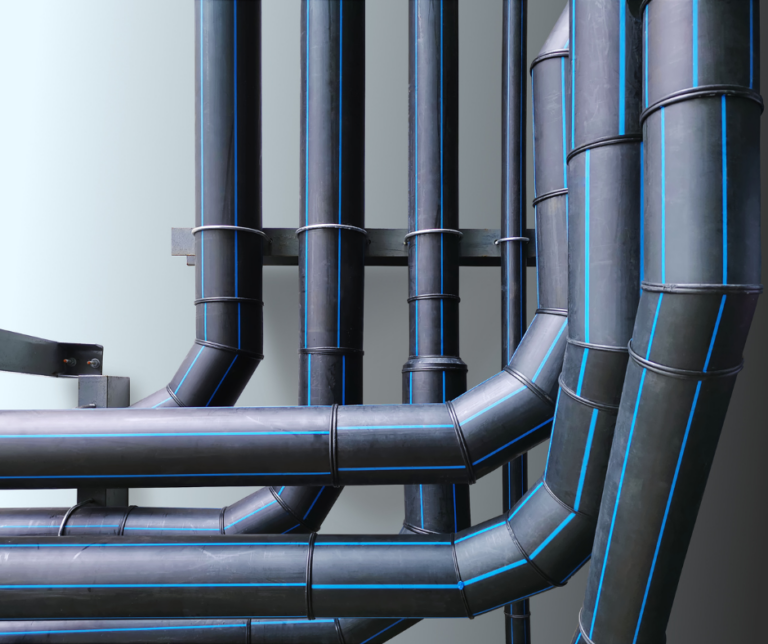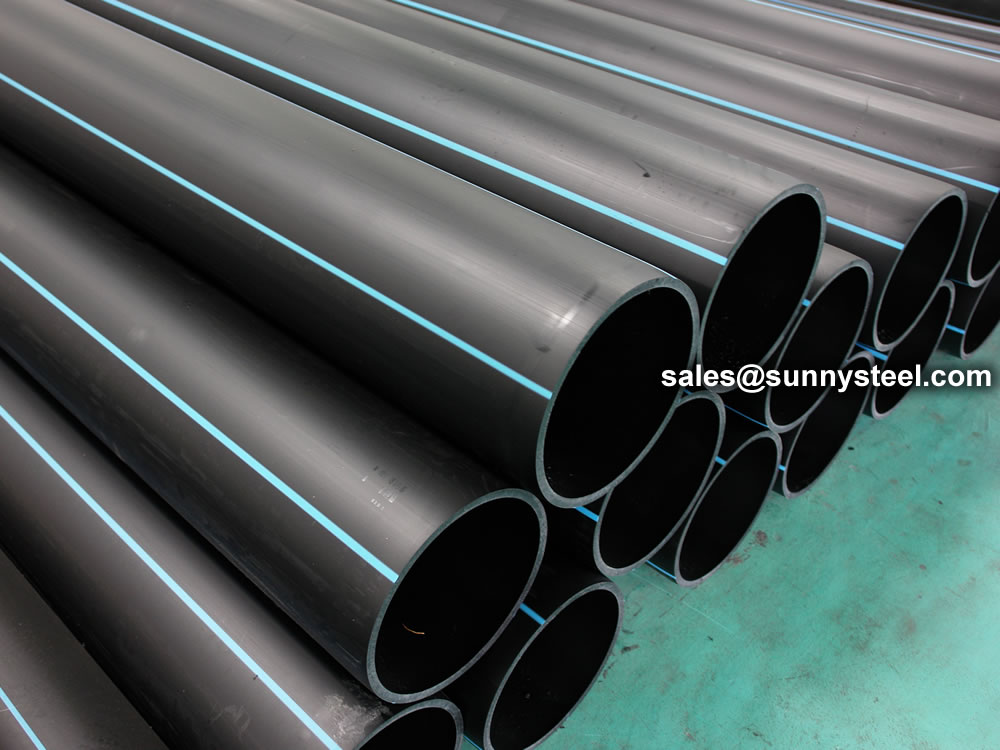Texas hdpe pipe manufacturer: Green Manufacturing
Explore the Production Refine Behind High-Quality HDPE Pipeline and Its Applications
The manufacturing process of top quality HDPE pipes is elaborate and methodical. It begins with the option of basic materials that improve performance. Following this, ethylene goes through polymerization to create resin, which is then formed with extrusion. Quality control is paramount, ensuring that the final item fulfills rigid criteria. The trip of HDPE pipes does not end with production. Their applications across numerous industries reveal a broader importance worth checking out.
Recognizing HDPE: Residences and Advantages

High-density polyethylene (HDPE) is a flexible polycarbonate understood for its durability and resistance to various ecological elements. This product exhibits outstanding tensile stamina, making it ideal for demanding applications. Its low-density structure adds to a light-weight product, assisting in convenience of taking care of and setup. HDPE additionally showcases remarkable resistance to chemicals, which reduces degradation when subjected to extreme compounds.
The product's low wetness absorption better improves its durability, making it ideal for usage in pipelines and tank. In addition, HDPE is resistant to ultraviolet (UV) radiation, making sure that items preserve their honesty even when exposed to sunlight. Its adaptability enables for the production of intricate shapes without compromising toughness. The green nature of HDPE, typically originated from recycled products, includes to its appeal, promoting lasting methods in production. In general, these buildings and advantages make HDPE a preferred selection for different commercial and consumer applications.
Basic Material Option for HDPE Production
The option of basic materials for HDPE manufacturing is necessary to verify the end product meets the preferred specs and top quality criteria. High-density polyethylene (HDPE) is mostly created from polymerized ethylene, originated from nonrenewable fuel sources such as natural gas or crude oil. The top quality of these feedstocks significantly affects the mechanical and thermal properties of the last HDPE.
Ingredients likewise play a substantial function in improving HDPE's efficiency, consisting of antioxidants, UV stabilizers, and colorants, which enhance durability and resistance to ecological factors. The selection process should consider not only the chemical composition of the raw products but additionally their handling attributes to ensure efficient production.
Furthermore, the sourcing of raw materials ought to focus on sustainability and conformity with ecological regulations, as responsible methods are critical in today's market. Eventually, careful basic material option lays the structure for generating premium HDPE pipelines appropriate for diverse applications.
The Extrusion Process: Shaping HDPE Pipeline
The extrusion procedure plays an important function in shaping HDPE pipelines, beginning with careful material preparation strategies that guarantee perfect circulation and uniformity. Equally essential is the layout of the die, which directly affects the last measurements and surface area top quality of the pipe. With each other, these aspects contribute substantially to the effectiveness and top quality of HDPE pipe manufacturing.
Product Prep Work Methods
Efficient production of HDPE pipes starts with thorough product prep work strategies, specifically the extrusion process. Throughout this stage, high-density polyethylene resin is first dried to eliminate wetness, making certain suitable circulation attributes. The material is then fed right into the extruder, where it undertakes heating and melting, changing into a viscous state. This home heating process is meticulously regulated to preserve the material's integrity and performance. The liquified HDPE is compelled via a die, shaping it into a constant pipeline type. Correct temperature level administration during extrusion is important, as it straight affects the material's homes and the last product top quality. As soon as shaped, the HDPE pipeline is cooled down and cut to defined sizes, ready for succeeding handling and applications.
Die Layout Relevance
Accuracy in die style plays a crucial duty in the extrusion process of HDPE pipelines. The die offers as the last shaping tool, straight affecting the pipe's measurements, wall thickness, and surface area finish. A well-designed die warranties consistent product circulation, decreasing defects such as abnormalities and weak places. The geometry of the die must be optimized to accommodate the certain homes of HDPE, including its viscosity and thermal behavior during extrusion. Additionally, the cooling rate of the product as it passes through the die can substantially affect the pipe's structural stability. Spending in innovative die modern technology is vital for manufacturers aiming to generate top notch HDPE pipes that satisfy market requirements and customer expectations.
Quality Assurance Steps in HDPE Production
Although different aspects influence the quality of HDPE pipeline production, efficient check my site quality control procedures are crucial to assure consistency and dependability in the last item. Trick quality assurance techniques include strenuous product examination, validating that the raw polyethylene satisfies well established standards for pureness and thickness. Throughout the extrusion procedure, specifications such plastic pipe end caps as temperature level, stress, and cooling time are very closely kept an eye on to maintain dimensional precision and structural honesty
On top of that, post-production testing is vital; suppliers typically conduct hydrostatic tests to examine the pipe's stamina and resistance to pressure. Aesthetic evaluations for surface flaws even more boost quality assurance. Accreditation from pertinent requirements organizations, like ASTM or ISO, provides an added layer of reputation. By applying these comprehensive quality control measures, manufacturers can reduce flaws, enhance performance, and make sure that the HDPE pipelines fulfill the details demands of numerous applications, eventually bring about customer satisfaction and rely on the product.
Applications of HDPE Pipe Across Industries
HDPE pipes are made use of throughout different sectors as a result of their durability and flexibility. In water circulation systems, they guarantee efficient distribution, while in wastewater monitoring, they provide trustworthy options for waste transportation. Furthermore, farming irrigation networks take advantage of HDPE's resistance to rust and versatility, making it an excellent option for contemporary farming practices.

Water Circulation Systems
A significant variety of sectors depend on high-density polyethylene (HDPE) pipes for effective water circulation systems. Known for their longevity and resistance to corrosion, HDPE pipes are widely used in community water supply networks, farming watering, and commercial applications. Their light-weight nature facilitates simple handling and setup, reducing labor prices and time. In addition, HDPE pipelines can fit numerous stress levels, making them appropriate for both reduced and high-pressure systems. hdpe pipe fittings Midland TX. The flexibility of the product enables smooth assimilation right into existing framework, decreasing the demand for substantial excavation. Moreover, HDPE's resistance to chemical leaching guarantees that the water delivered stays you can try this out safe and clean, making it a suitable selection for keeping the top quality of potable water across different industries
Wastewater Administration Solutions
Effective water distribution systems likewise pave the way for ingenious wastewater monitoring solutions, where high-density polyethylene (HDPE) pipes play a substantial function. Prominent for their resilience and resistance to deterioration, HDPE pipes are ideal for carrying wastewater in different settings. Their adaptability enables very easy setup in complicated settings, reducing the demand for considerable excavation. In addition, HDPE's smooth interior surface area decreases friction, enhancing circulation prices and performance. These pipelines are likewise resistant to chemical leaching, guaranteeing that contaminants do not endanger the surrounding setting. Industries, communities, and therapy facilities significantly rely upon HDPE pipelines for their dependability and long life, making them a favored option for contemporary wastewater administration systems. This adaptability highlights the crucial importance of HDPE pipelines throughout various applications.
Agricultural Watering Networks
Agricultural watering networks benefit substantially from using high-density polyethylene (HDPE) pipes, which supply effective and reliable water shipment to crops. HDPE pipelines are light-weight, making them very easy to move and mount, while their adaptability permits different configurations in varied terrains. These pipelines demonstrate outstanding resistance to corrosion, chemicals, and UV radiation, making certain resilience in rough agricultural atmospheres. In addition, their smooth indoor surface area minimizes rubbing loss, optimizing water flow and reducing energy costs connected with pumping. The durability of HDPE pipes, frequently going beyond 50 years, adds to reduce maintenance and substitute expenditures. Farmers progressively rely on HDPE pipelines to enhance watering effectiveness and advertise sustainable farming practices, inevitably leading to enhanced plant returns and resource preservation.

Future Fads in HDPE Pipeline Innovation
As the need for lasting and effective facilities grows, innovations in HDPE pipe technology are positioned to change numerous industries. Arising fads include the assimilation of smart technologies, such as sensing units and IoT capacities, which promote real-time monitoring of pipe conditions, reducing upkeep expenses and stopping leakages. In addition, the advancement of advanced manufacturing techniques, such as 3D printing, is enabling the production of facility, tailored pipeline designs that deal with specific project needs.
The focus on recycling and circular economy methods is driving the technology of HDPE pipelines made from recycled materials, boosting sustainability. Improved jointing approaches, such as electro-fusion and mechanical fittings, are likewise boosting setup effectiveness and integrity. The expanding focus on environmental regulations is pressing suppliers to embrace greener production procedures, making certain that HDPE pipes not only satisfy industry standards yet additionally foster an even more sustainable future for framework development.
Regularly Asked Questions
Exactly How Does HDPE Contrast to Other Plastic Materials?
HDPE outshines numerous other plastic products relating to longevity, chemical resistance, and versatility. Its low thickness and high tensile toughness make it optimal for various applications, frequently exceeding options in both performance and durability.
What Are the Environmental Influences of HDPE Production?
The environmental effects of HDPE manufacturing consist of greenhouse gas discharges, energy consumption, and possible contamination from producing processes. In addition, inappropriate disposal can lead to dirt and water contamination, increasing issues regarding long-lasting environmental effects.
Can HDPE Piping Be Reused?
Yes, HDPE pipelines can be reused. Lots of centers approve made use of HDPE for processing, transforming it into brand-new products. This recycling contributes to sustainability efforts, reducing plastic waste while saving sources and power in the manufacturing cycle.
What Is the Lifespan of HDPE Pipeline?

Just How Do Temperature Level Variations Impact HDPE Pipe Efficiency?
Temperature level variants substantially influence HDPE pipe performance, affecting adaptability and stamina. High temperatures can result in softening, while low temperature levels may cause brittleness, inevitably affecting the pipeline's durability and suitability for various applications in varied environments.